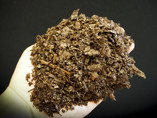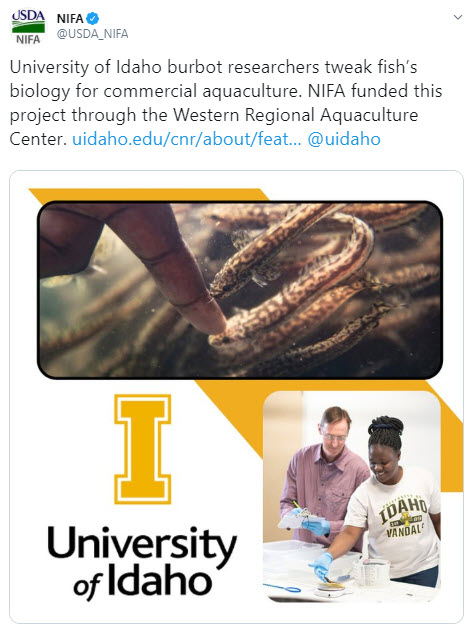|
Having trouble viewing this email? View it as a Web page.

|
|
|
Editor: Kelly Sprute Dec. 11, 2019
Making a Difference

Researchers Find Some Forests Crucial for Climate Change Mitigation, Biodiversity
A study by Oregon State University (OSU) researchers has identified forests in the western United States that should be preserved for their potential to mitigate climate change through carbon sequestration, as well as to enhance biodiversity. The findings, published in Ecological Applications, are important because capping global temperature increases at 1.5 degrees Celsius above pre-industrial levels. The five-year study supported by NIFA identified, and targeted for preservation, forests with high carbon sequestration potential, low vulnerability to drought, fire and beetles, and high biodiversity value. Read the full OSU news article.
Oregon Coast Range old growth forest. Photo courtesy of Bev Law OSU College of Forestery
|
|
|

Our staff continue to process awards. As a reminder, if you are a grantee having ASAP (Automated Standard Application for Payments) issues, as a first step, please contact the NIFA ASAP team at ASAPCustomerService@usda.gov. While ASAP is a financial disbursement system owned and operated by the Department of Treasury, this system is used by many federal agencies, including NIFA, to manage disbursements to grantees. The NIFA ASAP team will help you determine the root cause of the issue, and will help resolve the issue, if within the NIFA ASAP team’s purview. More information online at NIFA's grants page.
|

Preview of 2020 USDA Ag Outlook Forum
What is in store for February's USDA Agricultural Outlook Forum - centered on the theme "The Innovation Imperative: Shaping the Future of Agriculture?" Listen to the USDA broadcast.
|

Helping Plant Nurseries Reduce Runoff
You may have heard how excess nutrients, such as phosphorus, can run-off of crop fields. This can cause harm when the nutrients end up in rivers and lakes. However, there are other sources of excess nutrients you might not think of, such as the pots nursery plants come in. Phosphorus runoff can be harmful to water quality. Because of this, researchers are looking into ways nurseries can keep phosphorus where it belongs. This research was partially funded by NIFA’s Hatch Program. Read the full American Society of Agronomy press release.
Milled pine bark is the basis of most growing media used to grow shrubs and trees in containers. Photo courtesy of Jake Shreckhise.
|

NIFA Invests in Rural Veterinary Services across the Country
NIFA recently announced 16 Veterinary Service Grants Program (VSGP) awards, nine Education, Extension and Training grants and seven Rural Practice Enhancement grants to help mitigate veterinary service shortages in the United States. This program is designed to support education and extension activities that will enable veterinarians, veterinary students, and veterinary technicians gain specialized skills and practices. The Agricultural Act of 2014 authorized the establishment of the VSGP as a companion to the Veterinary Medical Loan Repayment Program to incentivize service in veterinarian shortage situations. Ultimately, VSGP will bolster the capacity of private veterinary practitioners to provide food animal veterinary services in rural veterinarian shortage locations.
Rural Veterinarian, photo courtesy of Getty Images.
|
Secondary Education, Two-Year Post-secondary Education, and Agriculture in the K-12 Classroom Challenge Grants Program (SPECA)
The SPECA program:
- promotes and strengthens secondary education and two-year postsecondary education in the food, agriculture, natural resources and human (FANH) sciences in order to help ensure the existence of a workforce in the United States that's qualified to serve the FANH sciences system; and
- promotes complementary and synergistic linkages among secondary, two-year postsecondary, and higher education programs in the FANH sciences in order to advance excellence in education and encourage more young Americans to pursue and complete a baccalaureate or higher degree in the FANH sciences.
Read the full SPECA funding opportunity.
NIFA Tweet

|
|
|
NIFA’s mission is to invest in and advance agricultural research, education, and extension that solve societal challenges. NIFA’s investments in transformative science directly support the long-term prosperity and global preeminence of U.S. agriculture. Keep informed about NIFA, USDA, our land-grant and non-land-grant university partners, and stakeholders with the NIFA Update. Read past issues online, sign up for email updates or follow us on Twitter @USDA_NIFA, #NIFAImpacts or LinkedIn @usda-nifa.
If you wish to submit a news item or information, send an email to NIFAUpdate.
USDA is an equal opportunity lender, provider, and employer.
|
|